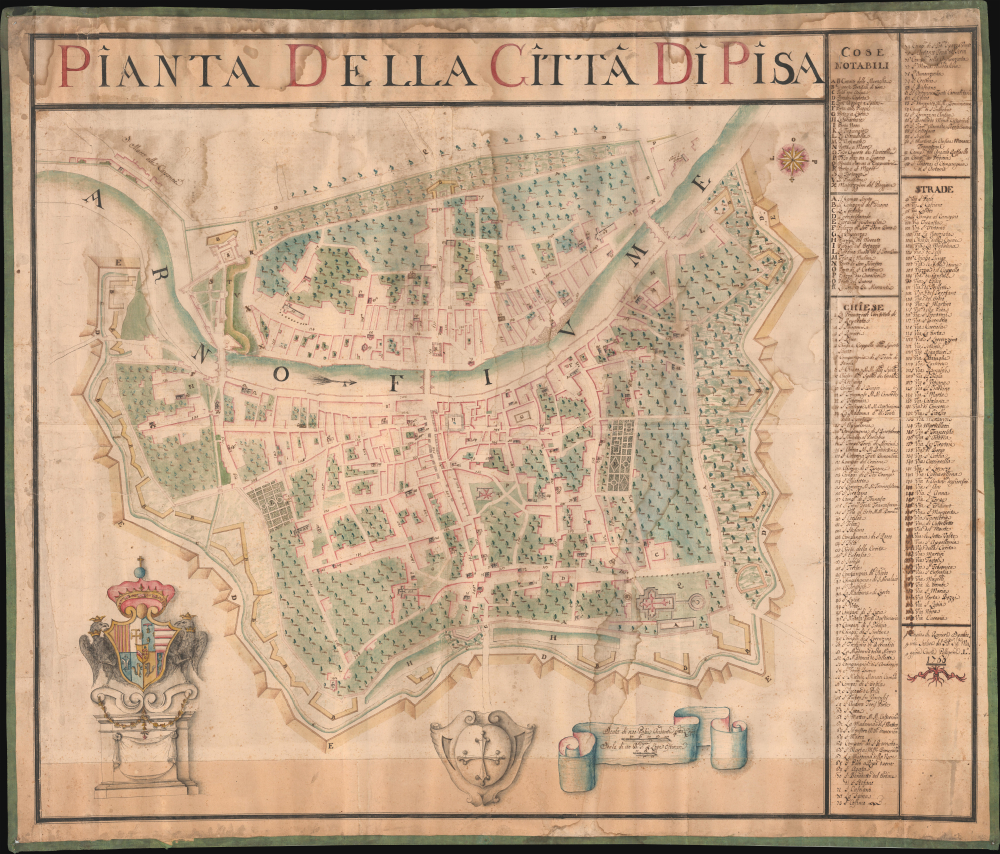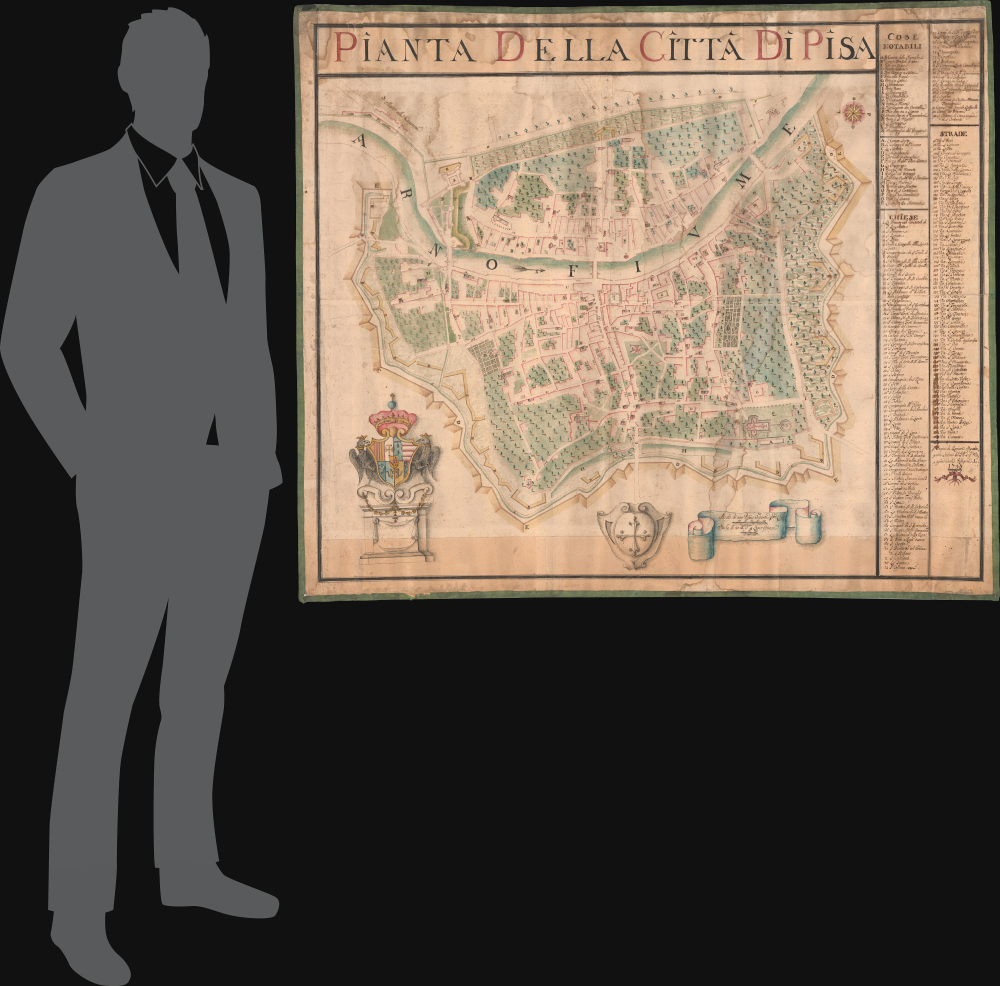Digital Image: 1760 Pellegrini / Spadaccini Manuscript Wall Map of Pisa
Pisa-pellegrini-1760_d
Title
1760 (dated) 38 x 44.5 in (96.52 x 113.03 cm)
Description
FOR THE ORIGINAL ANTIQUE MAP, WITH HISTORICAL ANALYSIS, CLICK HERE.
Digital Map Information
Geographicus maintains an archive of high-resolution rare map scans. We scan our maps at 300 DPI or higher, with newer images being 600 DPI, (either TIFF or JPEG, depending on when the scan was done) which is most cases in suitable for enlargement and printing.
Delivery
Once you purchase our digital scan service, you will receive a download link via email - usually within seconds. Digital orders are delivered as ZIP files, an industry standard file compression protocol that any computer should be able to unpack. Some of our files are very large, and can take some time to download. Most files are saved into your computer's 'Downloads' folder. All delivery is electronic. No physical product is shipped.
Credit and Scope of Use
You can use your digial image any way you want! Our digital images are unrestricted by copyright and can be used, modified, and published freely. The textual description that accompanies the original antique map is not included in the sale of digital images and remains protected by copyright. That said, we put significant care and effort into scanning and editing these maps, and we’d appreciate a credit when possible. Should you wish to credit us, please use the following credit line:
Courtesy of Geographicus Rare Antique Maps (https://www.geographicus.com).
How Large Can I Print?
In general, at 300 DPI, you should at least be able to double the size of the actual image, more so with our 600 DPI images. So, if the original was 10 x 12 inches, you can print at 20 x 24 inches, without quality loss. If your display requirements can accommodate some loss in image quality, you can make it even larger. That being said, no quality of scan will allow you to blow up at 10 x 12 inch map to wall size without significant quality loss. For more information, it is best consult a printer or reprographics specialist.
Refunds
If the high resolution image you ordered is unavailable, we will fully refund your purchase. Otherwise, digital images scans are a service, not a tangible product, and cannot be returned or refunded once the download link is used.
Cartographer S
Ranieri Spadaccini (fl. c. 1760 - 1807) was an Italian engraver and surveyor active in Florence and elsewhere in Tuscany in the late 18th century. Generally working in collaboration with other surveyors and engineers, he is credited with producing manuscript surveys and schematics of Pisa (1760), the villages of Vellano and Massa e Cozzile northwest of Florence (1782 - 1783), the doors of the city walls of Pisa and Livorno (1784), and the Coteto Vineyard near Livorno (1788). As an engraver, he prepared plates for the works of Machiavelli and Dante's La Divina commedia. Spadaccini appears to have been for a time in the employ of the Veronese nobleman Ignazio Pellegrini (1715 - 1790), with whom he prepared a survey of Pisa and designed at least one church in the city. More by this mapmaker...
Ignazio Mariano Baldassarre Pellegrini (September 22, 1715 - October 2, 1790) was an Italian nobleman, architect, surveyor, and scholar of the military arts. Born to the prominent Pellegrini family of Verona, which was said to be of German origin, Ignazio was the sixth child of Count Bertoldo Pellegrini and Countess Giulia Serego. After receiving a basic education at home, Pellegrini became a page to Princess Violante Beatrice of Bavaria at the Court of Tuscany. Ignazio showed an early aptitude for drafting, engineering, and the military arts, for which his family was famous. After the princess died, he was enlisted to work for the Grand Duke Giovan Gastone de' Medici, but soon afterwards decided to join the Austrian army to fight alongside his brother, where he fought in the War of the Polish Succession (1733 - 1738). Before and during his military service, he had undertaken a study of military fortifications that would influence his later career and life. While still enlisted in the army, he was commissioned to design a church in Ferrara, where his regiment was stationed. After the end of the war, he went to serve in the court of Giovan Gastone de' Medici and became the official Grand Ducal Engineer while maintaining his military role, reaching the rank of Colonel in the Grand Duke's royal regiment by 1769. He was tasked with a number of architectural projects by the Grand Duke, including completing the Palazzo Pitti and plans for a Cappella Reale to be built nearby, though this project was interrupted by the death of the duke and an economic crisis in 1763. Similar projects to build a grand staircase for the Medici's Uffizi complex in Florence and renovate the shops on the Ponte Vecchio were also left incomplete. Though his Florentine projects largely came to naught, Pellegrini did design numerous buildings (churches, homes, and tombs) in Pisa, especially, as well as Livorno and Verona. In 1776, Ignazio returned to Verona permanently, devoting himself to writing books on the history of art and architecture, along with an autobiography, all of which were unfinished at the time of his death. His architectural work was confined to the renovation of homes of other prominent Veronese families. At an unknown date, Pellegrini married Lucrezia del Lante of Pisa, with whom he had two children. Late in life, he was a well-known figure among the grandees of Verona due to his military exploits, travels, and service in the Medici court, but no doubt he was frustrated by the inability to complete his most ambitious literary and architectural works. Learn More...




